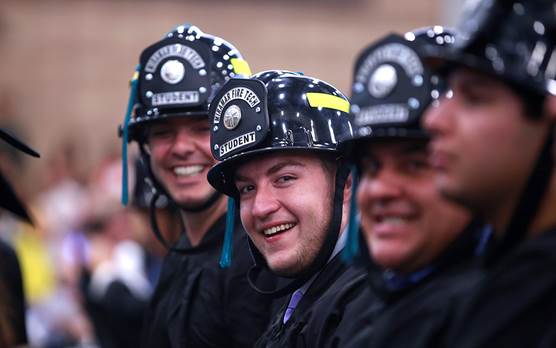Daily Business Report-May 14, 2018
File photo of Fire Technology graduates from San Diego Miramar College. The college trains the majority of the region’s first responders. (Photo courtesy of SDCCD)
First Community College Students Earning Bachelor’s
Degrees Are Among Spring’s San Diego Graduates
The first group of community college students in California earning a bachelor’s degree will be among those taking the stage this spring when the San Diego Community College District awards 10,751 degrees and certificates to students graduating from San Diego City, Mesa, and Miramar colleges and San Diego Continuing Education.
Besides those earning a bachelor’s degree through the state’s Baccalaureate Pilot Program at Mesa College in the growing field of Health Information Management, more than two dozen students who are part of the initial group of San Diego Promise free college program will be earning their associate degrees just two years after the effort was launched. Many others will earn certificates, and some will transfer to four year institutions such as UC San Diego, San Diego State University, Cal Poly Pomona, and San Francisco State University. Without the San Diego Promise, many students would not have the opportunity to go to college.
In all, the second largest community college district in California is awarding a record 3,833 associate degrees, an increase of 15 percent from 2016-17. That includes increases of 8 percent at Mesa College, 14 percent at City College, and 32 percent at Miramar College.
Commencement Schedules:
San Diego Miramar College— May 18, 1 p.m. inside Hourglass Fieldhouse on campus.
San Diego Mesa College— May 19, at 3 p.m. at the University of San Diego Jenny Craig Pavilion, 5998 Alcala Park, 92110.
San Diego City College— May 25, 5 p.m., Spreckels Organ Pavilion in Balboa Park.
San Diego Continuing Education— June 1, 5 p.m., Spreckels Organ Pavilion in Balboa Park.
_______________
City of San Diego Asks for Court Review
of Competing Mission Valley Initiatives
The city of San Diego has filed petitions with the Superior Court seeking pre-election legal review of two competing citizens’ initiatives that seek control over City property in Mission Valley. The two initiatives are the San Diego River Park and Soccer City Initiative (commonly known as the Soccer City Initiative) and the SDSU West Campus Research Center, Stadium and River Park Initiative (commonly known as the SDSU West Initiative). Both initiatives have qualified for the ballot and can be placed before voters in November 2018.
The SDSU West Initiative proposes the sale of approximately 132 acres of city-owned real property, which includes the site of SDCCU Stadium, formerly Qualcomm Stadium, to San Diego State University or an SDSU auxiliary organization for development purposes.
The Soccer City Initiative proposes the 99-year lease of approximately 233 acres of city-owned real property, which includes the stadium site as well as noncontiguous property in Murphy Canyon, to a “qualified lessee” for development purposes. (The Initiative defines a “qualified lessee” so narrowly that only one entity currently meets the definition — the same entity that is a major supporter of the Initiative.)
“By seeking pre-election guidance from the courts, the city hopes to avoid a situation where voters act on measures that are later found to be legally invalid,” City Attorney Mara W. Elliott said. “Even if the court finds no problems with the measures, it may narrow post-election issues, which will save taxpayer money and potentially expedite city actions to implement a successful measure.”
_______________
San Diego Selected as National
Unmanned Aircraft Testing Partner
San Diego has been selected to participate in a new program by the U.S. Department of Transportation to advance the testing of unmanned aircraft technology, grow the innovation economy and create jobs. Announcement was made by the cities of San Diego and Chula Vista and the San Diego Regional EDC.
“From wireless technology to human genomes, San Diego is renowned for its innovative spirit and talent that can’t be matched anywhere else,” Mayor Faulconer said. “This designation brings together some of our brightest minds in local government and private industry to develop cutting-edge technologies that are going to take robotic and aerial innovations to the next level.”
The U.S. Department of Transportation’s “Unmanned Aircraft Systems Integration Pilot Program” is an opportunity for state, local and tribal governments to partner with private sector innovators, operators and manufacturers to accelerate the development of drone technology.
“This announcement proves San Diego companies, organizations, academics, government and nonprofits are exceptionally well-positioned to advance the adoption into the national airspace,” said Lauree Sahba, chief operating officer for the San Diego Regional Economic Development Corporation. “Not only does this program elevate San Diego as a research and development hub, but it also brings enormous potential to our economically diverse region.”
_______________
Cannabis Tax Revenues Total
$60.9 Million in First Quarter
Tax revenue from the cannabis industry totaled $60.9 million since January 1, which includes state cultivation, excise and sales taxes, the California Department of Tax and Fee Administration reported. It does not include local tax revenue collected by cities or counties.
Beginning on Jan. 1, two new cannabis taxes went into effect: a cultivation tax on all harvested cannabis that enters the commercial market and a 15 percent excise tax on the purchase of cannabis and cannabis products. In addition, cannabis and cannabis products are subject to state and local sales tax at the time of retail sale.
California’s excise tax on cannabis generated $32 million in revenue for the first quarter of calendar year 2018. The cultivation tax generated $1.6 million, and the sales tax generated $27.3 million in revenue. Medicinal cannabis is exempt from sales tax if the purchaser holds a valid Medical Marijuana Identification card.
_______________
IDEA World Convention
Coming to San Diego June 27
IDEA Health & Fitness Association, the world’s leading organization of fitness and wellness professionals, is bringing the IDEA World Convention to the company’s headquarters city of San Diego, June 27–July 1, 2018. This annual event hosts more than 14,000 national and international personal trainers, group fitness instructors, owners and managers, mind-body professionals, and nutrition professionals.
The convention will be held at the San Diego Convention Center and adjoining Manchester Grand Hyatt. For more information or to register, visit www.ideafit.com/world.
IDEA World offers a comprehensive experience that includes world-renown education on fitness and nutrition science, in-depth training for business owners and managers, and fun and inspiring workouts and workshops from industry leaders. This year’s program features more than 350 sessions led by 225 of the most successful and experienced experts in their field, all designed to provide fitness professionals with the tools they need to build a successful career. Topics include personal training techniques and theory, exercise science and research, small and large group training, niche audiences, nutrition and behavior change, business, marketing, technology, mind-body programming, group exercise programs, dance and barre, and the latest in indoor cycling, among many others.
_______________
SDSU Receives Most-Admired
Education Provider Award
San Diego State University was named The Malin Burnham Awards’ recipient for the most-admired education provider in San Diego County, a credit to the institution’s community-orientation and service. Selected from a group of six area educational institutions, the award is granted to a college, university or school district for “helping students from disadvantaged backgrounds succeed.” SDSU is nationally recognized for its commitment to diversity and for increasing graduation rates for all students, while narrowing achievement gaps among student populations.
The Malin Burnham Awards, a special event of the nonprofit Reality Changers organization, was created to honor those who have had the greatest philanthropic impact in the region. Most meaningful, each of the six categories for the award is decided by community voting. In receipt of this award, SDSU would like to thank the San Diego community for this designation.
In all, the nonprofit organization recognizes five other categories: most-admired foundation, most-admired news source, most-admired business, most admired public leader and most-admired organization.
_______________
Lead Paint Makers Balk at
Huge Bill for Toxic Cleanup
— Instead They Want You to Pick Up the Tab
By Laurel Rosenhall | CALmatters
Three companies found to have sold toxic lead paint for decades—despite knowing it posed health hazards for children—are waging a major battle to avoid paying the several hundred millions of dollars in liability that California courts have slapped on them.
And they’re asking you, the California voter, to help them get their way.
After losing an 18-year-long legal fight, ConAgra, NL Industries and Sherwin Williams are now working on two different fronts to overturn the ruling, which says they must pay toclean up lead paint in older homes in 10 cities and counties across California.
The companies have hired a slew of lobbyists to push their agenda in the state Legislature and poured $6 million into a campaign to put an initiative on the November ballot that would shift clean-up costs to taxpayers.
Their argument: The ruling rewards landlords who have neglected their properties, and also creates new burdens for homeowners whose houses have lead paint but do not qualify for abatement funding based on criteria set by the court.
The effort has kicked up an intense response from Democratic legislators who represent the cities and counties that sued the companies in 2000 over the hazards posed by lead paint.
“The lead paint companies are the new tobacco companies of 2018. After many, many decades of… knowingly and intentionally deceiving the public about their products, they are now trying to escape liability through whatever way they can,” said Democratic Assemblyman David Chiu, whose city of San Francisco was among the plaintiffs.
“We need to make sure that someone is going to pay for tens of thousands of children who are being poisoned by lead.”
Lead was a common paint ingredient in the early 20th century. Over time scientists found that lead exposure causes brain damage in young children. In 1951 manufacturers began putting a warning label on lead paint, and in 1978 stopped selling lead paint in the United States. But many old homes still have lead paint on the walls or windowsills. And it is dangerous when it deteriorates because children may eat paint chips or inhale toxic dust.
The court decision—which the state Supreme Court recently declined to review on appeal—requires the companies to pay into a fund that would be used to clean up lead paint in homes built before 1951 in seven counties (Santa Clara, Alameda, Los Angeles, Monterey, San Mateo, Solano, Ventura) and three cities (Oakland, San Diego and San Francisco). Those jurisdictions combined are home to almost half the population of California. The exact amount the companies must pay is still being determined. The trial court set it at $1.15 billion to cover homes built before 1981, but the appellate court ruled that only homes built before 1951 should be covered and directed the trial court to reduce the amount.
The ruling doesn’t require complete removal of lead paint from those homes, but says they must be fixed by sealing old paint or replacing parts of windowsills or doors. Priority for repairs goes to homes where children have been poisoned by lead, or where there’s a history of violating building codes and laws meant to prevent lead poisoning.
“Property owners who have neglected their responsibility to those families now get a windfall abatement plan,” said Tony Dias, a lawyer for Sherwin Williams. He addedthat the paint companies would appeal their loss to the U.S. Supreme Court.
Meanwhile, the ballot measure the paint companies have sponsored would reverse the ruling, block future lawsuits for similar claims, and create a bond using taxpayer funds to payfor repairing an array of environmental hazards in homes across the state—not just the 10 places that sued. The $2 billion bond could be used to remedy mold and asbestos in addition to lead paint. With interest, the bond would cost taxpayers$3.9 billion.
“It’s a broader solution to the problem we’re facing,” said Kendall Klingler, a spokeswoman for the ballot measure campaign.The ruling is problematic for homeowners in the 10 municipalities whose houses were built between 1951 and 1981, the campaign contends, because it deems the lead paint in those homes a public nuisance but does not provide funding to abate it. “Overturning the court ruling will obviously benefit the paint companies but it’s really beneficial to homeowners. Right now their fates are tied as long as this court ruling stands,” Klingler said.
It’s rare for groups that lose in court to try to overturn an unfavorable ruling on the ballot. But it’s not uncommon for interest groups lobbying for a new law in the Legislature to simultaneously launch a ballot measure drive. The threat can be used as leverage to get what they want from the Legislature instead
.It’s not yet clear if that’s the goal of the paint companies here. They’ve submitted the signatures necessary to put their initiative on the November ballot and counties are now checking if they are valid. Initiative backers could pull their measure off the ballot up until June 28. They have launched a publicity campaign that calls on the Legislature to “craft a real solution”—but so far no bills have been introduced that advance their aim.
For now the paint companies are working with other business interests to kill a slate of bills introduced by legislators from the regions that brought the lawsuit. Their bills would expand the scope of the court ruling and make it easier for people to sue over lead paint. If the companies have any shot of making a deal in the Legislature, one bloc of lawmakers will be critical: the moderate Democrats who are typically the swing vote in stand-offs between environmentalists and big business.
The paint companies’ campaign has reported making payments to David Townsend, a political consultant who has close ties to the caucus of moderate Democrats. He wouldn’t talk about the strategy he’s crafting but said that generally speaking, “most organizations would rather work it out in the Legislature than pay for a big ballot measure.”The leader of the moderate caucus said he’s met with the paint company lobbyists but that conversations are in early stages and the issue isn’t a huge priority for him.
“Hopefully we can come to a legislative solution that protects Californians, protects children and takes care of any homes that need to be abated,” said Assemblyman Adam Gray, a Merced Democrat. “But at the end of the day, the folks that are responsible for the lead paint ought to be the ones who pay.”
CALmatters.orgis a nonprofit, nonpartisan media venture explaining California’s policies and politics.




